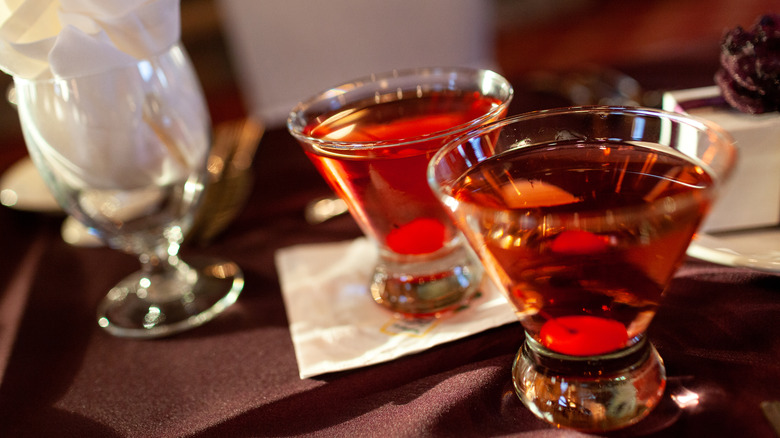What's The Difference Between An Aperitif And A Digestif?
Aperitifs and digestifs are essential elements of a European-style meal, bookending the dining experience with tantalizing and satisfying beverages. Serving an aperitif is like ringing a dinner bell, calling your guests to sip, snack, and chat before settling in to eat in earnest, and a digestif marks the close of the evening, subtly signaling to guests that the party's over — time to go home.
While you've probably enjoyed an aperitif or digestif (or both), you may not know that there's more to them than meets the eye. Though timing is a key difference between aperitifs and digestifs, they also serve specific and unique purposes as part of a dining experience. Part tradition, part science, by sandwiching supper between these two types of drinks, you can elevate even the simplest table spread to an unforgettable meal. Keep reading to learn what aperitifs and digestifs are, what they're for, and how to enjoy them.
What is an aperitif?
The word "aperitif" is derived from "aperire," meaning "to open" in Latin, which is exactly what such a drink is meant to do — unlock your palate and get you ready for a meal. An aperitif is typically a low-proof beverage, such as a liqueur, fortified wine, or even beer, served before the start of a meal. Aperitifs can stand alone or be served alongside appetizers as part of a pre-meal cocktail hour known as "aperitivo," common in Italy, France ("apéro"), and Spain ("la hora del vermut").
Because aperitifs are meant to stimulate your appetite, they're typically fizzy, dry, or acidic — or some combination of the three. The Aperol spritz is a perfect example of the ideal aperitif cocktail — the refreshing effervescence of the soda balances the sweet, slightly bitter flavor of the liqueur, awakening your senses so they're fully prepared to savor the meal to come. Sparkling dry wines, gin and vermouth cocktails, and sherry are also popular aperitifs, as well as the classic Campari and soda.
What is a digestif?
A digestif — which means "digestive" in French — is a strong alcoholic drink enjoyed after a meal, but until the 18th century, digestifs were primarily used medicinally. They tend to have a relatively high alcohol content and intensely herbal, spicy, bitter, and occasionally slightly sweet flavor profile from the botanicals and other ingredients meant to help digest a big dinner. Popular digestifs include ouzo, sweet vermouth, mezcal, Chartreuse, and limoncello. Digestif cocktails are not unheard of, but the liqueurs are typically served straight up.
Experts believe that the bitterness of digestif liqueurs mimics the taste of toxic plants your ancient ancestors may have encountered in their environment, stimulating the body to rapidly digest what you've already eaten to eliminate the potentially offensive intruder ASAP. Though digestifs are perfectly safe to consume, this biological reaction can ease the uncomfortable, weighed-down feeling that often follows after a heavy meal.
Aperitifs mark the start of a big meal
The main difference between an aperitif and a digestif is timing — an aperitif is served before a meal, and a digestif is served after. Aperitif cocktails can be sipped on their own, but in Europe, especially in Italy, aperitifs are often part of a social ritual known as aperitivo. In the early evening hours in many Italian cities, the streets fill with locals enjoying a "passeggiata" — a stroll about town, often culminating in an aperitivo with friends in the piazza before heading home for dinner. The aperitif itself, along with light snacks like crisps, cheeses, and fruit, helps to stimulate the appetite and rouse your senses so that you can fully enjoy the meal that is to come.
Digestifs, on the other hand, come after dinner. They're the perfect antidote to an uncomfortable, overly full belly, as their bitter herbal ingredients encourage digestion so that you can refasten your belt and bid your dining partners goodnight before heading home. Digestifs can also be sweet, served alongside dessert or standing on their own, signaling that the big meal has concluded.
Digestifs are stronger
While aperitifs tend to be light cocktails with a low total alcohol content, digestifs are usually stronger and served neat. This difference is, in part, due to tradition. The popularity of the aperitivo arose at a time when serving alcohol to women on an empty stomach was believed to be inappropriate, so cafés would serve low-proof cocktails alongside snacks like crackers, fruit, and cheese before dinner. As the aperitivo ritual became ingrained in European culture, so, too, did the habit of serving light, fizzy beverages before a meal. After dinner, of course, the ladies' stomachs are no longer empty, and the post-meal digestifs can be as strong as they like.
But there are scientific reasons behind serving stronger drinks after dinner and lighter drinks before. Alcohol can dull the taste buds, so having a high-proof drink before dinner could suppress your appetite, ruining your meal before it even starts. Digestifs were also originally used medicinally, long before they were ever part of an after-dinner ritual, and serve a medicinal purpose to this day, aiding digestion and easing the bloat of a heavy meal. So it makes intuitive sense to sip a digestif straight-up rather than diluting it with mixers in order to enjoy its soothing effects. Finally, your body eliminates alcohol faster on a full stomach, so a strong drink after supper won't leave you staggering the way it might on an empty stomach.
Aperitifs are more acidic
Aperitif cocktails tend to be lighter and more acidic than digestifs, whose rich, herbal, often bitter flavors are an appetite suppressant. Aperitifs need to stimulate the appetite, not stifle it, so they typically feature brighter flavors. The higher acidity in an aperitif (and the salty snacks often nibbled with it) makes your mouth water, a Pavlovian stimulus that signals mealtime to your brain, while the bitterness of a digestif sends the alert to stop eating.
There are exceptions to every rule, of course. Though digestifs tend to be bitter and herbal, they are occasionally sweet. Italian limoncello, for example, is a popular digestif, and while it's much sweeter than the usual digestif liqueur, its fresh dessert-like flavor and high alcohol content tell your body that dinner is done. Irish cream is another surprisingly sweet digestif, but because it's typically served alongside (or as) dessert or stirred into a cup of coffee, it also makes a satisfying sendoff after supper.





